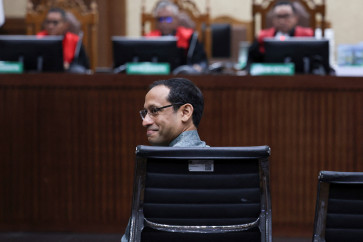Popular Reads
Top Results
Can't find what you're looking for?
View all search resultsPopular Reads
Top Results
Can't find what you're looking for?
View all search resultsGovt grapples with fires
Inferno: Firefighters work to extinguish a forest fire at the Sebangau National Park area in Palangkaraya, Central Kalimantan, on Saturday
Change text size
Gift Premium Articles
to Anyone
I
nferno: Firefighters work to extinguish a forest fire at the Sebangau National Park area in Palangkaraya, Central Kalimantan, on Saturday.(Reuters/Willy Kurniawan)
The government is scrambling to control land and forest fires in Sumatra and Kalimantan, which have disrupted flights, caused hundreds of thousands of people to suffer from acute respiratory infections (ISPA) and brought the air quality in neighboring Malaysia and Singapore to a dangerous level.
Dozens of flights to and from Sepinggan International Airport in Balikpapan, East Kalimantan, Supadio International Airport in Kubu Raya and Pangsuma Putussibau Airport in Kapuas Hulu, both in West Kalimantan, have been canceled, rerouted or delayed due to smog, Antara reported.
Meanwhile, air quality in Singapore has reached an unhealthy level for the first time since 2016, The Straits Times reported.
The Indonesian Health Ministry said in a statement on Friday that the unhealthy air quality caused by land and forest fires had led people in the affected provinces to suffer from ISPA, with Palembang in South Sumatra recording 106,550 patients, Jambi city in Jambi 61,147 patients, Palangkaraya in Central Kalimantan 23,324 patients and Pekanbaru in Riau 9,512 patients.
The ministry said it had distributed more than 1 million face masks to the affected provinces alongside those provided by local administrations, many of which have suggested their residents avoid outdoor activities.
Sporting face masks, hundreds of Sampit residents in East Kotawaringin regency of Central Kalimantan performed istisqa (mass prayers) on Saturday to ask for rainfall, which they hoped could wash away the smog that had been blanketing the area for days and disrupting their activities.
Data showed that at a PM10 concentration, Sampit's air quality stood at 434 micrograms per cubic meter (μg/m3), much higher than the safe limit of 150 μg/m3. The region previously recorded a dangerous level of air quality at 555 μg/m3.
National Disaster Mitigation Agency (BNPB) head Lt. Gen. Doni Monardo, Indonesian Military (TNI) commander Air Chief Marshal Hadi Tjahjanto and National Police chief Gen. Tito Karnavian flew to Riau on Sunday to look into the land and forest fires in the province.
The authorities said they had had a hard time dousing fires as dropping water bombs would not be enough to cover the vast area of land affected and that it would require rain. The rainy season, however, will not hit the country until October and weather modification methods to make artificial rain have not been possible in several regions given the absence of clouds.
Doni said attempts to douse the fires had become even more difficult as at least a quarter of the burned land was peatland.
"We've deployed 42 helicopters to douse the peatland fires with the support of the private sector, military and Environment and Forestry Ministry, but it doesn't guarantee that the fires could be put out," he said during a press briefing in Jakarta on Saturday.
Peatland Restoration Agency (BRG) head Nazir Foead told reporters on the sidelines of the briefing that 16 percent of the hotspots discovered on peatland were found within prioritized areas for peatland restoration that had been intervened on by the agency and its partners.
Data compiled by the Meteorology, Climatology and Geophysics Agency (BMKG) showed that Riau and Central Kalimantan had seen an increase in hotspots as of Saturday compared to 2015, when the country saw a deadly haze crisis. Riau saw 5,630 hotspots in 2019, slightly higher than the 4,965 hotspots in 2015, while a spike was observed in Central Kalimantan with 11,455 hotspots this year compared to 6,156 hotspots in 2015.
According to the BMKG's Himawari-8 satellite images as of Saturday afternoon, smog had engulfed Riau, Jambi, South Sumatra, West Sumatra, Riau Islands, Kalimantan and neighboring Peninsular Malaysia, Sarawak of Malaysia and Singapore.
BMKG chairwoman Dwikorita Karnawati said satellite records showed that transboundary haze from the country had entered parts of Malaysia for an hour on Wednesday, before reappearing on Friday morning, also affecting Singapore.
"The scope of the haze-hit area is continuously changing as influenced by the southerly wind, which is why smog also appears in Singapore," she told reporters on the sidelines of the briefing.
Dwikorita denied reports that transboundary haze from Indonesia had affected neighboring countries prior to Wednesday, adding that satellite images by the BMKG and Singapore-based ASEAN Specialised Meteorological Centre (ASMC), which Malaysia uses, showed that smog from Sumatra and Kalimantan had not crossed into the countries.
Indonesia and Malaysia have been in a spat over smog caused by land and forest fires, which turned into a blame game between the authorities of the two countries over the past week.
Land owned by three Malaysian firms and one Singaporean company were among the 42 firms' concessions sealed by the government, as hotspots had been spotted there, said the Environment and Forestry Ministry's law enforcement director general, Rasio "Roy" Ridho Sani.
Another plot of land owned by a smallholder was also sealed, he said, adding that the sealing, covering almost 6,000 hectares of land mostly located in West and Central Kalimantan, aimed to prevent fires and speed up investigations.
Only four firms, all oil palm plantations, have been named suspects for causing land and forest fires, compared to the hundreds of individual suspects, according to the National Police. All firms are currently at the first stage of investigation while a handful of individual suspects have proceeded to later stages of investigation.
This has prompted criticism from activists who argued that law enforcement against large firms was weak.
Roy added that the law enforcement process against firms was more complicated given that the authorities must look further into identifying the people in charge, compared to individuals who were commonly caught in the act.










